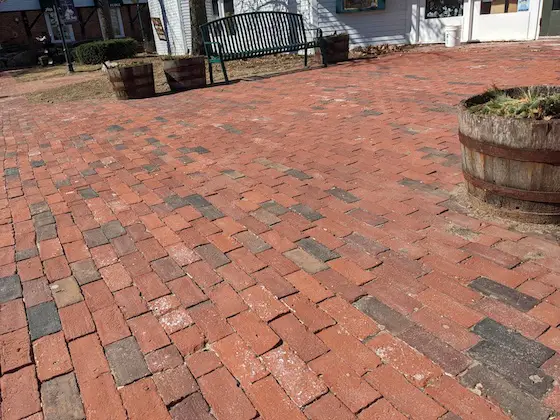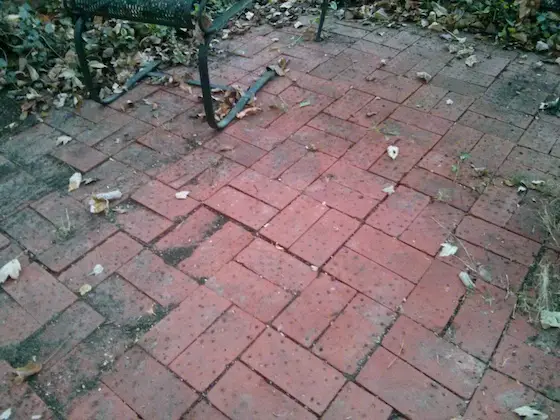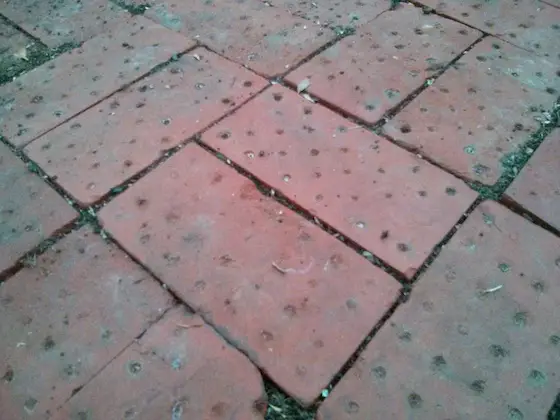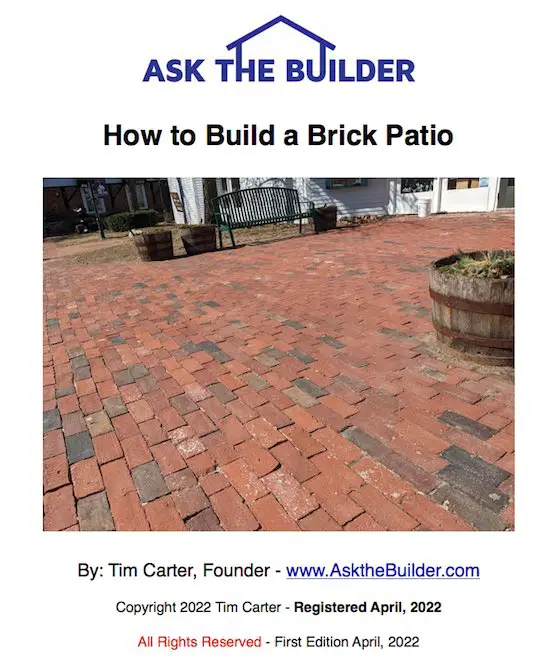How to Build a Patio Using Clay Paving Brick

How to Build a Patio Using Clay Paving Brick | This brick plaza has been in service for many decades in harsh New England weather. You can build one similar to this with my help! Copyright 2022 Tim Carter
How to Build a Patio - Use Clay Paving Brick for Best Results
There’s something soothing about brick patios and sidewalks if you ask me, my wife, and my dear mother-in-law who is no longer with us. I was introduced to the magic of brick paving before I married my wife. Back fifty years ago my future mother-in-law wanted a private patio built in her backyard using deep-red paving brick.
This patio was nestled under the shade of two giant maple trees that were up on a lawn supported by a small brick retaining wall her husband had built fifteen years earlier. The patio was the perfect size measuring 10 feet by 16 feet. A 30-inch-wide walkway made using the same brick connected the patio to the driveway apron.

This is the patio I built for my mother-in-law! Yes, it's just a small section. This photo was taken 45 years after I installed the brick. It still was in excellent condition except for the light coat of algae. That can be cleaned using certified organic Stain Solver oxygen bleach. NEVER use chlorine bleach as it will kill all nearby trees and vegetation.
The trouble was that her husband, a traditional general-practice medical doctor, was far too busy going back to medical school at age 55. Medical practice was compartmentalizing in the early 1970s and he knew he needed to be board certified in anesthesia to follow his passion. Thinking that I could help increase the odds of both saying “Yes” to me requesting their daughter’s hand in marriage, I volunteered to do build the patio and sidewalk. My future mother-in-law immediately took me up on the offer.
She had seen an article in a magazine with a photo of what she wanted. In the article, all it said was to install the brick over a bed of compacted sand with some Portland cement in it. That was the extent of my plans and specifications!
Use Hard Clay Paving Brick
My future mother-in-law went to a local brick supplier that had both new and recycled brick. She selected a recycled special paving brick meant to be placed horizontally in the ground. Not all bricks can handle this wear. The issue was there was still some mortar on the brick and I had to hand chisel it all off. The size of the bricks was perfect such that you could create a herringbone pattern. In other words, the brick measured exactly 4 inches wide by 8 inches long. They were 2 and 3/4-inches thick.

This is a close-up shot of the actual solid clay paving brick I used on my mother-in-law's patio. Note how the width of two of the brick equals the length of one brick. This relationship allows you to create all sorts of interesting patterns. She wanted this cross-hatched pattern.
I dug out all the soil, I got help from my future father-in-law one afternoon installing a string to ensure the edge of the walkway and patio would be in a straight line, and two weeks later the patio was finished. My future mother-in-law was beaming with happiness! That patio was still in exceptional shape forty-five years later! It would still be in use today but an investor purchased the house and ripped out the patio only to put in a dark-gray stamped-concrete patio in its place.
The Paving Brick Disaster Sidewalk
My second attempt at a brick paving job ended in disaster. My plan worked and my wish was granted to marry my high-school sweetheart. I was busy building my construction company. We bought a stunning old five-bedroom home and my darling wife wanted a curved brick sidewalk from the front porch to the driveway.
I could only work on it in the evenings and on weekends so I decided to take a shortcut. I simply dug a pathway about 6 inches deep, put some sand down, compacted it, and then laid on the sand a 1-inch-thick paving brick. It looked superb.
But I noticed that if you stepped on the edge brick they’d tilt and drift into the grass. Then the sugar ants took over. Each day I’d notice small mounds of sand the ants would bring to the surface as they built their underground nests. It was a nightmare and a complete and utter failure. My wife said to rip it out and do it right
I then did some research and discovered that you could build a brick patio or sidewalk that would not only last for many decades, but it would also remain perfectly smooth. My mother-in-law didn’t want the smooth look. She wanted her patio to have very slight undulations in the brick so it looked as if the patio and walkway had been in for 200 years. My new bride wanted a smooth look.
The Old Master Craftsman Mason's Secrets
Fortunately a year earlier I had a conversation with a retired master mason who shared with me how to get cement stucco to bond permanently to new concrete. He had built hundreds of stucco exterior stairs in his career. He told me his method was also the best way to bond brick to horizontal concrete.
To ensure my new front sidewalk would not fail, I removed all the brick pavers and salvaged them. I then dug out the sand and saved it too. I did have to sift it and clean it for use in my second attempt.
I then dug the pathway deeper so I could install a poured concrete pathway with 1/2-inch steel bars in it. The steel rods ensured the concrete would not crack and separate. I then mixed up cement mortar with hydrated lime added to the mix. The old mason told me to use cement paint as an extra adhesive to ensure the mortar would not separate from the concrete slab.
It worked so well, that I built a stunning patio in the back of this house with sloping terraced steps to get to it. I then did the same thing at my last new home constructing two huge patios. All of this work looks as good as the day I installed it and it’s decades-old!

This is the COVER for my step-by-step PDF download file that shares how to build your dream brick patio. It's got photos, illustrations, links to videos, links to top tools, etc. Satisfaction GUARANTEED!
Step-by-Step How-To Instructions with Illustrations & Videos
I’ve prepared detailed how-to instructions with illustrations and photos showing how to do the two time-tested brick installation methods. Included are all the secret recipes for the mortar, cement paint, videos, brick specifications, and lots of tips so you can create stunning brick sidewalks and patios. This instant-download PDF file guarantees professional results. Go here to get the best instructions on the Internet for building a clay paving brick patio, sidewalk, or driveway.

Column 1450
One Response to How to Build a Patio Using Clay Paving Brick